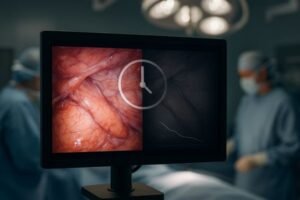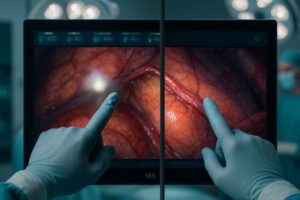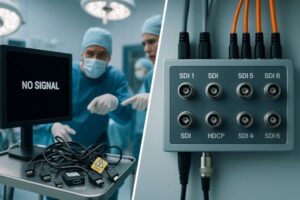Are you finding it hard to choose the right display size for complex surgical needs? A cramped view can hinder precision. Bigger isn’t always better if it clutters the OR.
A 43-inch surgical display offers a versatile solution for various procedures. It enhances visualization in laparoscopy, robotic surgery, hybrid ORs, teaching, and collaborative case reviews. It balances a large, clear view with practical OR integration.
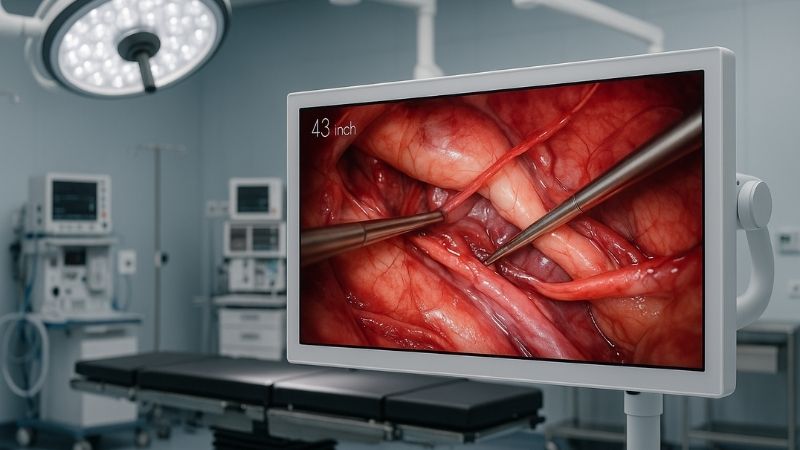
Selecting the right display is a critical decision in any surgical setting. As someone working for Reshin, a specialist monitor manufacturer, I’ve seen firsthand how display technology impacts surgical workflow1 and outcomes. My first insight is that a 43-inch surgical monitor2 often strikes an ideal balance. It provides an immersive viewing experience3 without overwhelming the often-crowded space of an operating room. This size allows surgeons like Dr. Amy Chen to see incredible detail. Let’s explore the top use cases where a 43-inch display truly shines.
1. Laparoscopic Procedures: Enhancing Precision with Large Field of View
Struggling with a small screen during delicate laparoscopic work? Limited views can make precise movements difficult. This can add stress and time to procedures.
A 43-inch display provides an expanded, detailed view of the surgical site. This allows surgeons to navigate more confidently and perform intricate tasks with greater precision during laparoscopy.
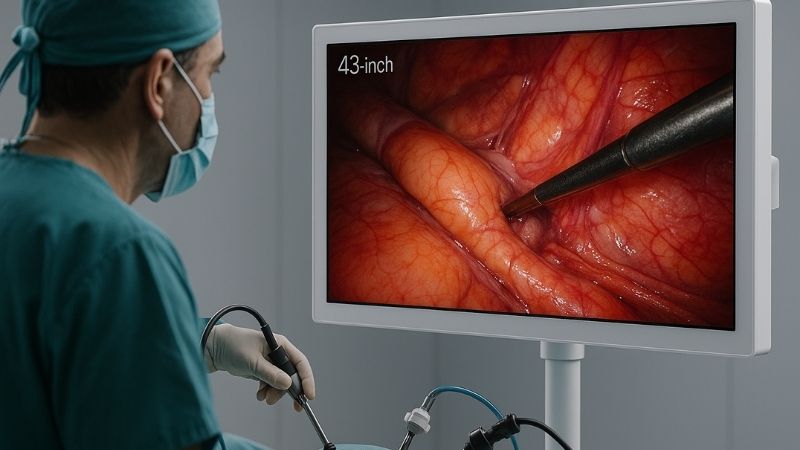
In laparoscopic surgery4, surgeons rely entirely on the monitor to see inside the patient’s body. The instruments are small, and the field of view through the laparoscope can be narrow. A 43-inch display5 significantly enlarges this view. It’s like looking through a much bigger window. This larger image makes it easier to identify anatomical structures, differentiate tissues, and guide instruments with pinpoint accuracy. I remember a conversation with a surgeon who upgraded from a smaller screen. He said the 43-inch display felt like it "brought the surgical site6 closer" without him needing to physically strain.
This enhanced visualization is crucial for several reasons:
- Improved Depth Perception: While 2D, a larger, clearer image can give better cues for depth.
- Reduced Eye Strain: Surgeons can sit further back, adopting a more ergonomic posture.
- Better Team Coordination: The entire surgical team can clearly see the procedure, improving communication and anticipation.
The clarity offered by a high-resolution 43-inch screen, especially a 4K one, means even minute details are visible. This is vital when working near delicate nerves or blood vessels. From my experience, a larger, clearer field of view directly contributes to surgical efficiency and potentially better patient outcomes. It allows surgeons to work with more confidence.
2. Robotic-Assisted Surgeries: Supporting Multi-Angle Visualization
Is coordinating multiple video feeds during robotic surgery a challenge on smaller screens? Switching views or crowding information can break concentration. This can impact the surgeon’s flow.
A 43-inch display excels in robotic surgery by comfortably showing multiple video feeds or data overlays simultaneously. This provides the surgeon with a comprehensive view, supporting complex, multi-angle visualization requirements.
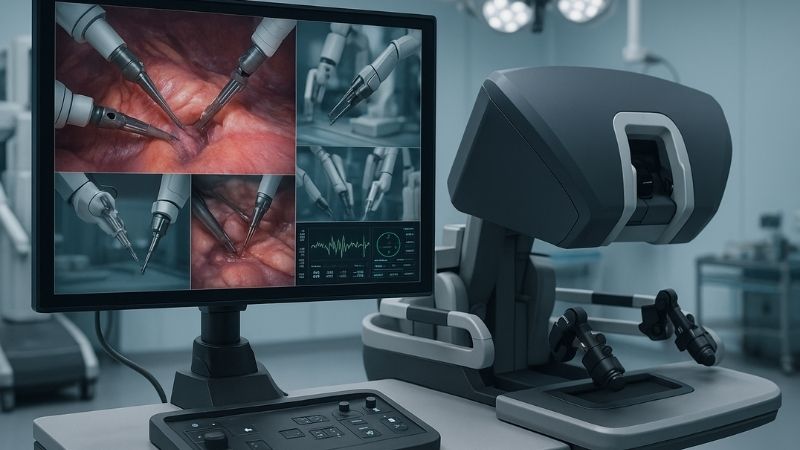
Robotic-assisted surgery often involves sophisticated imaging systems. The surgeon, typically seated at a console, needs to see the primary surgical field, perhaps an endoscopic view, and potentially other data like patient vitals or pre-operative scans. My second insight highlights that for robotic surgeries, screen size is crucial. A 43-inch display7 provides ample screen real estate. This allows for various Picture-in-Picture (PiP) or Picture-by-Picture (PbP) configurations without making any single image too small to be useful.
Consider the Da Vinci Surgical System8, for example. It provides magnified 3DHD vision. Displaying this rich visual information on a large, high-resolution 43-inch screen enhances the immersive experience. It helps the surgeon feel fully connected to the operative site. The ability to see auxiliary information alongside the main surgical view, without needing to switch inputs or glance at a separate monitor, streamlines workflow. This maintains focus and can improve intraoperative efficiency. At Reshin, we understand that seamless integration of real-time visuals is key. Our MS430PC, for example, with its 4K clarity and multi-source input capabilities, is well-suited for these demanding environments. The large screen helps the surgeon manage the complex visual data inherent in robotic procedures more effectively.
3. Hybrid Operating Rooms: Integrating Diverse Imaging Sources
Feeling overwhelmed by the number of different screens in your hybrid OR? Managing multiple displays for various imaging modalities can be complex. It can also take up valuable space.
A 43-inch display can act as a central visualization hub in hybrid ORs. It integrates feeds from C-arms, CT scanners, angiography systems, and endoscopes onto one large, clear screen.
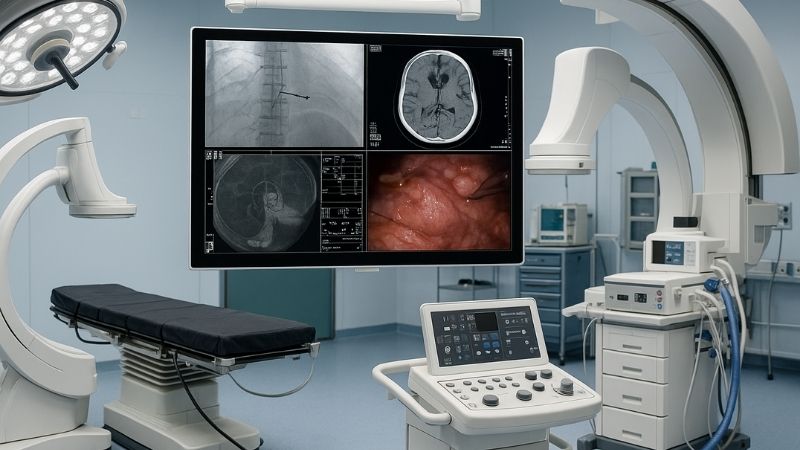
Hybrid operating rooms are advanced surgical suites. They combine traditional surgical capabilities with sophisticated imaging systems like fixed C-arms, intraoperative CT scanners, or MRI machines. This allows for both open and minimally invasive procedures, often with real-time image guidance. The challenge here is managing and displaying information from these diverse sources effectively. My second insight also applies here: the 43-inch format allows seamless integration of real-time visuals and reference images. Instead of having multiple smaller monitors, a large 43-inch display9 can consolidate these views.
Imagine a complex cardiovascular procedure. The surgeon might need to see a live fluoroscopy image, pre-operative CT angiograms, and hemodynamic data simultaneously. A 43-inch display with good Picture-by-Picture (PbP)10 or Quad View capabilities can present all this information clearly. This unified view enhances intraoperative decision-making and team communication. The high resolution, often 4K on such displays, ensures that even when the screen is divided, each segment remains detailed. From my work at Reshin, I know our displays like the MS430PC are designed for this. They handle multi-source signals and offer the anti-glare performance needed in brightly lit ORs. This makes the complex environment of a hybrid OR more manageable.
4. Broadcasting and Live Surgical Demonstrations
Are your live surgical broadcasts or demonstrations limited by small, unclear screens? Viewers in an auditorium or remote locations need to see every detail. Poor visuals undermine the learning experience.
A 43-inch display provides a large, high-definition canvas ideal for broadcasting surgeries or for live demonstrations. It ensures that both local and remote audiences can clearly see procedural details.
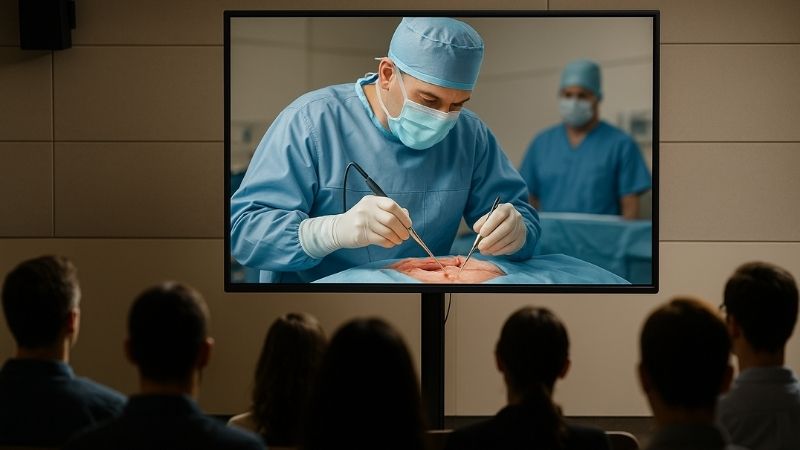
Live surgical broadcasts and demonstrations are vital for medical education and knowledge sharing. Whether it’s for training residents, sharing new techniques at a conference, or remote proctoring, the visual experience is paramount. A 43-inch display11 offers a compelling solution for the primary display in the OR that is being recorded or for the viewing audience. Its large size ensures that even those seated further away in an auditorium can follow the procedure. When combined with 4K resolution12, the level of detail captured and displayed is exceptional. This allows viewers to appreciate the nuances of the surgical technique, identify anatomical landmarks, and understand the surgeon’s movements.
I recall helping set up for a conference where our Reshin displays were used for live case transmissions13. The feedback was overwhelmingly positive regarding the clarity and size. The 43-inch screen effectively conveyed the intricate steps. My fourth insight also touches on this: clarity and screen sharing are vital. A 43-inch monitor supports both. Furthermore, for the recording itself, a high-quality output from such a display ensures that the archived material is also of high educational value. It’s not just about the live event; it’s about creating a lasting educational resource. The visual impact of a large, clear display makes a significant difference in how effectively complex surgical information is communicated.
5. Multidisciplinary Team Collaboration in Complex Cases
Is it difficult for your entire surgical team to view critical images simultaneously on a smaller screen? Huddling around a small display can lead to miscommunication. It can also impede efficient teamwork.
A 43-inch display facilitates better multidisciplinary team collaboration. Its large size and wide viewing angles allow surgeons, nurses, anesthesiologists, and technicians to see critical information clearly from various positions.
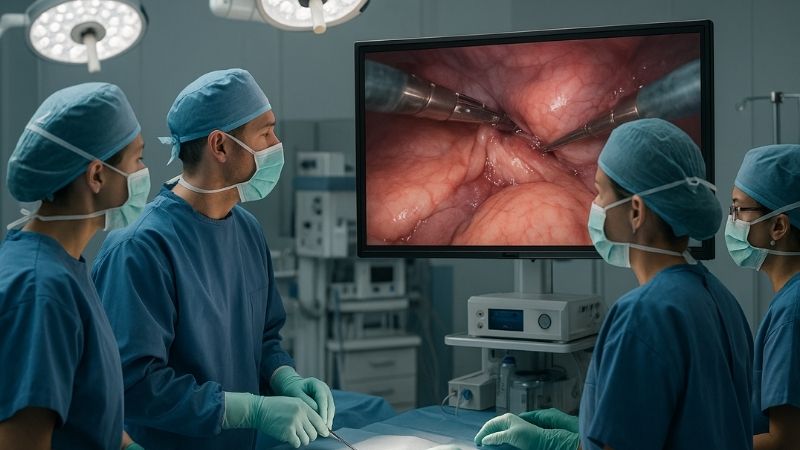
Modern surgery is rarely a solo performance. It’s a team effort. During complex cases, effective communication14 and shared understanding among all team members are crucial for patient safety and procedural success. My fifth insight is particularly relevant here: when multiple team members rely on the same display, viewing angles and brightness uniformity become critical. A high-quality 43-inch [medical monitor](https://reshinmonitors.com/medical-grade-monitors/anatomy-teaching-monitors/ "medical monitor")15 addresses these needs effectively. Its generous size means that even people standing a bit further away or off to the side can still see the screen clearly.
Consider a trauma case or a complex cancer surgery. There might be several specialists involved. The primary surgeon, assistant surgeons, scrub nurse, circulating nurse, and anesthesiologist all need access to visual information. This could be the main surgical view, patient vitals, or radiological images. A large 43-inch display acts as a common visual reference point. Good quality displays, like those we strive to produce at Reshin, ensure that image quality, brightness, and color do not degrade significantly when viewed from an angle. This means everyone in the OR sees the same accurate detail. This shared visual understanding16 supports better decision-making, anticipation of needs, and overall team cohesion. It helps avoid situations where someone misses a crucial visual cue because they couldn’t see the screen properly.
6. Teaching Hospitals: Elevating Surgical Training Experience
Are you looking for ways to improve how surgical trainees learn in the OR? Small screens can make it hard for students to observe. They might miss crucial details of a procedure.
In teaching hospitals, a 43-inch display significantly enhances the surgical training experience. It provides a large, clear view for students and residents. This allows them to closely follow procedures and learn techniques effectively.
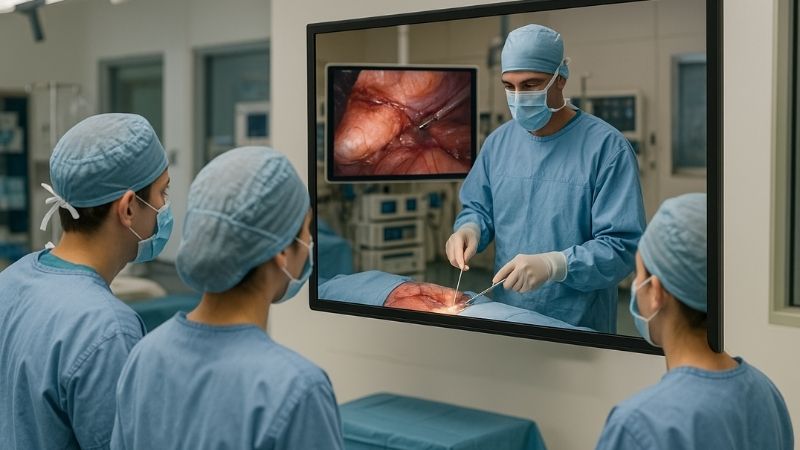
Teaching hospitals are the bedrock of medical education. Providing trainees with the best possible learning environment is essential. When it comes to observing surgeries, clear visualization17 is key. My fourth insight states that in teaching environments, clarity and screen sharing capabilities18 are just as vital as size, and a 43-inch monitor supports both. Trainees often stand a few feet away from the surgical field, or even further back if the OR is crowded. A 43-inch display ensures they get a view that is almost as good as the surgeon’s. They can see intricate anatomical details, the handling of instruments, and the nuances of surgical technique.
This enhanced visibility has several benefits for education:
- Better Understanding: Trainees can more easily correlate the surgeon’s actions with the visual feedback on the screen.
- Increased Engagement: A clear, large image keeps trainees more engaged and focused on the procedure.
- Facilitates Q&A: Instructors can easily point out specific features or steps on the large screen for discussion.
I’ve seen how our Reshin displays contribute to these environments. The ability to clearly see what’s happening helps bridge the gap between textbook knowledge and practical application. A 4K 43-inch display, for instance, allows instructors to zoom in on specific areas without significant loss of detail, further enriching the learning experience. It helps train the next generation of surgeons like Dr. Amy Chen.
7. Neurosurgery and Spine Procedures: Demanding Pixel-Perfect Clarity
Do your neurosurgery or spine procedures require the absolute highest level of image detail? Even tiny misjudgments can have serious consequences. Standard displays might not offer sufficient precision.
For neurosurgery and spine procedures, a 43-inch 4K display offers the pixel-perfect clarity needed. Surgeons can visualize delicate neural and vascular structures with extreme detail. This supports precise, safe interventions.
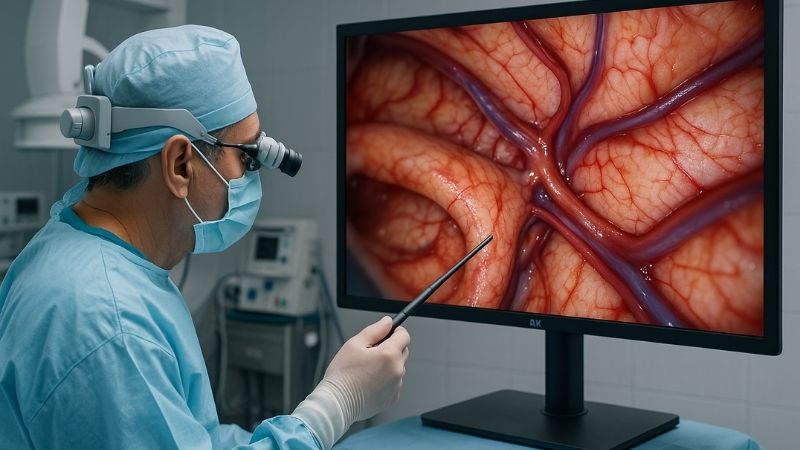
Neurosurgery and complex spine surgery are among the most demanding surgical disciplines. They involve working with incredibly delicate structures like the brain, spinal cord, nerves, and tiny blood vessels. In these procedures, there is absolutely no room for error. Therefore, the visualization tools must provide the highest possible level of detail and accuracy. A 43-inch display, particularly one with 4K resolution (which is approximately 8.3 million pixels), offers exceptional clarity. This high pixel density means that images are incredibly sharp, and even the smallest structures can be clearly delineated.
This "pixel-perfect" clarity is vital. It allows surgeons to:
- Identify Critical Anatomy: Precisely distinguish nerves from surrounding tissues.
- Navigate Safely: Avoid damaging vital structures during dissection or implant placement.
- Confirm Placement: Ensure accurate positioning of screws, cages, or electrodes.
The large size of the 43-inch screen further aids this by making these highly detailed images easier to see from a comfortable working distance. My experience in surgical display marketing, especially with products like the Reshin MS430PC which offers 4K clarity, has shown me how much surgeons in these fields value this combination of size and extreme resolution. It helps them perform these intricate procedures with greater confidence and precision.
8. 4K Endoscopic Visualization in Minimally Invasive Procedures
Are you aiming to maximize the benefits of 4K endoscopy systems? The full potential of 4K cameras can only be realized with a matching 4K display. Otherwise, detail is lost.
A 43-inch 4K surgical display is perfect for showcasing the rich detail from 4K endoscopes. It provides an immersive, true-to-life view. This enhances visualization in various minimally invasive procedures.
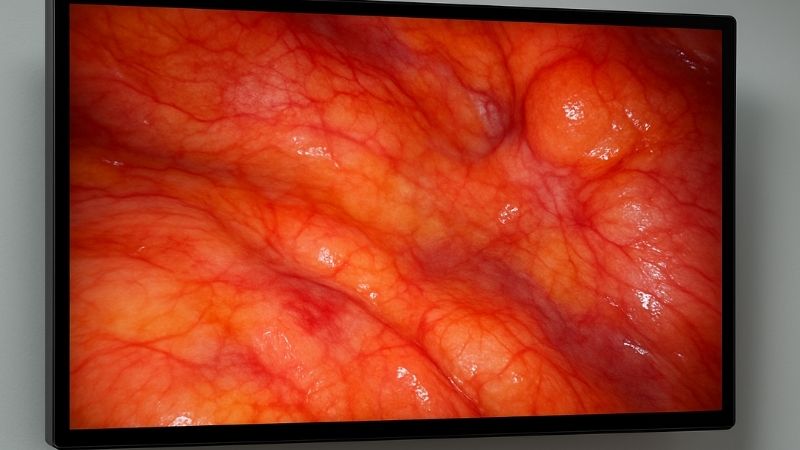
Minimally invasive surgery (MIS) relies heavily on endoscopic cameras to provide vision inside the body. The advent of 4K endoscopy19 has been a game-changer. These cameras capture images with four times the resolution of standard HD. This means significantly more detail, better color reproduction, and improved depth perception cues. However, to fully benefit from a 4K camera, you need a 4K display. Displaying a 4K signal on a lower-resolution monitor means you are not seeing all the information the camera is capturing.
A 43-inch 4K surgical display20 is an excellent partner for 4K endoscopic systems. The large screen size combined with the ultra-high resolution creates a stunningly clear and detailed image. Surgeons can see subtle tissue changes, tiny blood vessels, and other critical details that might be missed on a smaller or lower-resolution screen. This is particularly beneficial in procedures like advanced laparoscopy, thoracoscopy, or arthroscopy. As I’ve learned at Reshin, our goal is to ensure the display is not the limiting factor in the imaging chain. The Reshin MS430PC, with its 4K resolution, is designed to faithfully reproduce the output of these advanced camera systems. This level of detail can lead to more precise dissections, better identification of disease, and potentially improved patient outcomes in MIS.
9. Multi-Signal Display Modes: PiP, PbP, and Quad View Applications
Do you often need to view multiple video sources or types of information at once during surgery? Constantly switching inputs on a single-view display is inefficient. It can also be distracting.
A 43-inch display offers ample screen space for versatile multi-signal modes like Picture-in-Picture (PiP), Picture-by-Picture (PbP), and Quad View. This allows simultaneous display of various critical feeds.
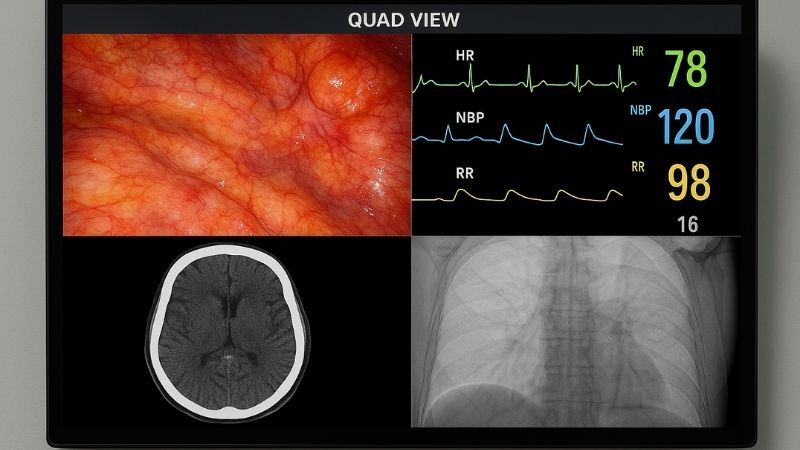
In many modern surgical procedures, surgeons need to monitor multiple sources of information simultaneously. This could include the primary endoscopic view, fluoroscopy, ultrasound, patient vital signs, or pre-operative images like CT scans or MRIs. A 43-inch display, with its large surface area, is ideal for utilizing multi-signal display modes. These modes allow the screen to be divided to show several sources at once.
Here’s a quick look at common modes and their benefits on a 43-inch screen:
| Display Mode | Description | Benefit on 43-inch Display |
|---|---|---|
| Picture-in-Picture (PiP) | Main image with a smaller inset image. | Large main view remains clear; inset is still easily legible. |
| Picture-by-Picture (PbP) | Screen split into two (or more) side-by-side images. | Each image retains significant size and detail. |
| Quad View | Screen split into four equal quadrants. | Allows monitoring of four sources; each quadrant is still usable. |
The key advantage of a 43-inch display here is that even when the screen is divided, each individual window remains large enough to be clearly visible and useful. On a smaller display, dividing the screen can make each segment too tiny to provide meaningful information. My experience with products like the Reshin MS430PC, which supports these multi-source inputs, confirms their value. Surgeons can customize the layout to suit the specific needs of the procedure, enhancing situational awareness and workflow efficiency without needing multiple separate monitors cluttering the OR.
10. Medical Imaging Review in Operating Room Environments
Is it cumbersome to bring separate review stations into the OR for looking at pre-operative scans? Accessing images quickly during surgery is vital. Delays can impact decision-making.
A 43-inch surgical display can also serve as an excellent platform for intraoperative medical imaging review. Surgeons can easily pull up and examine X-rays, CTs, MRIs, or pathology images on a large, clear screen.
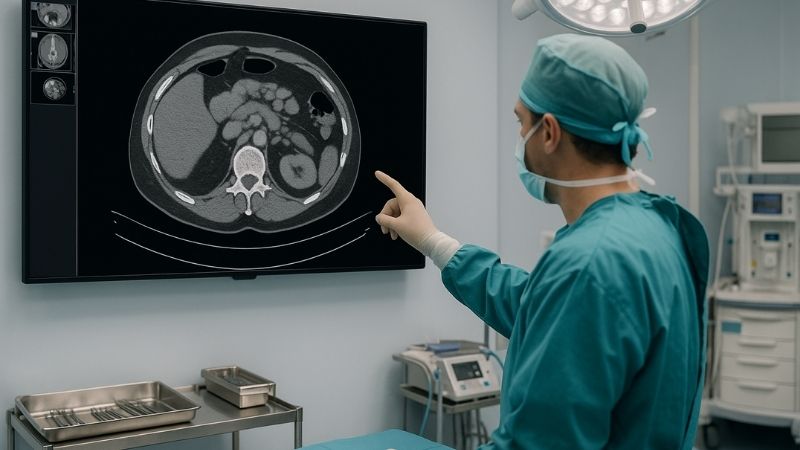
During surgery, there’s often a need to refer back to pre-operative diagnostic images. This might be to confirm anatomical landmarks, assess the extent of a tumor, or plan the next step of the procedure. Having a large, high-quality display directly in the OR that can show these images is incredibly beneficial. A 43-inch display, especially with 4K resolution21, provides the size and detail needed for effective radiological image review. Surgeons can zoom in on scans and see fine details without needing to move to a separate workstation outside the sterile field.
This capability streamlines the surgical workflow22. It allows for quick consultations and decisions based on all available information. For example, a neurosurgeon might want to compare the live operative view with a pre-operative MRI to ensure complete resection of a tumor. Or an orthopedic surgeon might review X-rays to confirm implant placement. The Reshin MS430PC, with its ability to handle various signal inputs and its high resolution, is well-suited for this dual role. It can switch from displaying the live surgical camera feed to showing DICOM images23 from the PACS (Picture Archiving and Communication System). This versatility makes the 43-inch display a valuable asset, maximizing its utility within the operating room and supporting informed, timely surgical decisions.
Conclusion
A 43-inch surgical display is a versatile tool. It enhances visualization across many procedures, from laparoscopy to complex robotic surgeries, supporting precision, collaboration, and training effectively. To experience the performance of advanced 43-inch surgical monitors, contact Reshin at martin@reshinmonitors.com.
-
Learn about the crucial role of display technology in optimizing surgical workflows and improving efficiency. ↩
-
Discover how a 43-inch surgical monitor can enhance surgical precision and improve outcomes in the operating room. ↩
-
Explore the significance of immersive viewing experiences in enhancing surgical performance and patient safety. ↩
-
Learn about laparoscopic surgery techniques, benefits, and advancements that improve patient outcomes and surgical precision. ↩
-
Explore how a 43-inch display enhances visibility and precision in laparoscopic procedures, making surgeries safer and more efficient. ↩
-
Discover the importance of surgical site visibility and its impact on the success of laparoscopic procedures. ↩
-
Explore how a 43-inch display can enhance surgical precision and efficiency in robotic-assisted procedures. ↩
-
Learn about the Da Vinci Surgical System’s advanced features and its impact on surgical success rates. ↩
-
Explore how a 43-inch display can enhance surgical procedures by consolidating multiple views for better decision-making. ↩
-
Learn about PbP technology and its role in providing clear, simultaneous views during complex surgeries. ↩
-
Explore how a 43-inch display enhances clarity and engagement in surgical education, making complex information more accessible. ↩
-
Discover the advantages of 4K resolution in capturing intricate surgical details, enhancing learning experiences for medical professionals. ↩
-
Learn about the significance of live case transmissions in medical training and how they facilitate real-time learning and skill development. ↩
-
Discover the vital role of effective communication in surgery and how it contributes to better patient outcomes and team performance. ↩
-
Explore how a 43-inch medical monitor enhances surgical teamwork and patient safety with its superior visibility and image quality. ↩
-
Learn about the importance of shared visual understanding in surgical settings and how it improves decision-making and team cohesion. ↩
-
Understanding the importance of clear visualization can improve surgical training outcomes and enhance the learning experience for trainees. ↩
-
Discover how screen sharing capabilities can facilitate better communication and learning in medical training environments. ↩
-
Explore the advantages of 4K endoscopy to understand how it enhances surgical precision and patient outcomes. ↩
-
Learn how a large 4K surgical display can enhance visualization and detail during complex surgeries. ↩
-
Explore how 4K resolution enhances surgical precision and image clarity, crucial for effective decision-making in the OR. ↩
-
Discover innovative technologies that streamline surgical workflows, enhancing efficiency and patient outcomes in the OR. ↩
-
Learn about DICOM images and their importance in surgical procedures for accurate diagnostics and planning. ↩

